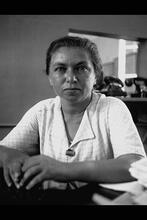Mary Moss
Mary Moss was educated in private schools and began writing for the Philadelphia Times and Philadelphia Press in 1900, covering topics from Yiddish theater to the lives of women working in cranberry bogs, and from child care to mental illness. She also wrote short stories published in Atlantic Monthly and The Nation, among other journals, and wrote two novels, A Sequence in Hearts, in 1903, and The Poet and the Parish, in 1906. While she mainly lived at home and nursed her parents through their final illnesses, she also travelled to research articles and performed with her piano quartet at the 1893 Chicago World’s Fair. After her parents died, she suffered her own illnesses, dying while on a tour of Europe.
Article
In a portrait published in Bookman magazine in 1903, Mary Moss says of herself, “If I ... knew this ‘fame’ was to be thrust upon me I’d miss-spend every Saturday afternoon, so as to have a dark past to draw on. As it is, I’ve ... never experienced anything in the least noteworthy.”
Mary Moss was born in Chestnut Hill, Philadelphia, on September 24, 1864, into an assimilated Jewish family. Her father was Dr. William Moss, a surgeon and a major in the Civil War, and her mother was Mary (Noronha) Moss. Their home was a meeting place for intellectuals, a tradition Mary Moss continued, living in the house her entire life.
Educated in private schools, Mary Moss began publishing in 1900, writing for the Philadelphia Times and the Philadelphia Press. She covered the Yiddish theater and wrote about subjects such as child care facilities, the lives of insane women, immigrant life, and women who worked in cranberry bogs in New Jersey. She also covered the popular expositions of her day.
Moss published stories, novellas, contemporary criticism, and articles in magazines including Bookman, Atlantic Monthly, and The Nation. Two published novellas, “Julian Meldohla” in Lippincott’s Magazine (1903) and “Judith Liebestraum” in Scribner’s (1904), have Jewish themes. She published two novels, A Sequence in Hearts (1903) and The Poet and the Parish (1906).
Beginning in 1892, Moss and Owen Wister, writer and friend, performed publicly in a piano quartet. Together, they traveled to the 1893 Chicago World’s Fair. Moss nursed both parents through fatal illnesses and suffered health problems herself before traveling in Europe. Mary Moss died in Catania, Sicily, on April 2, 1914.
Selected Works by Mary Moss
“Chronicle and Comment.” Bookman (1903).
“Judith Liebestraum.” Scribner’s (1904).
“Julian Meldohla.” Lippincott’s Magazine (1903).
The Poet and the Parish (1906).
Scrapbook of articles and stories, 1900–1904. John Hay Library, Brown University, Providence, R.I.
A Sequence in Hearts (1903).
AJYB 6 (1904–1905): 158–159.
JE 9 (1925).
Leonard, John W. Woman’s Who’s Who of America: A Biographical Dictionary of Contemporary Women of the United States and Canada, 1914–1915 (1914).
Payne, Darwin. Owen Wister: Chronicler of the West, Gentleman of the East (1985).
Robinson, Doris. An Index to Biographical and Autobiographical Sources (1984).
UJE.
Wallace, W. Stewart. Dictionary of North American Authors Deceased Before 1950 (1951).
Wister, Owen. “Mary Moss Died at Catania, April 2.” Transcript of memorial service, Baltimore, 1914. Brown University, Providence, R.I., and University of Virginia, Charlottesville.
WWWIA 1, 1897–1942 (1943).














